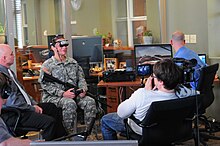User:BobLosn/Wearable technology
Medical Uses:[edit]


While virtual reality was originally developed for gaming, it also can be used for rehabilitation. VR headsets are given to patients and instructed to complete a series of tasks, but in game format. This has significant benefits compared to traditional therapies. For one, it is more controllable; the operator can change their environment to anything they desire including areas that may help them conquer their fear, like in the case of PTSD. Another benefit is the price. On average, traditional therapies are several hundred dollars per hour, whereas VR headsets are only several hundred dollars and can be used whenever desired. In patients with neurological disorders like Parkinsons, therapy in game format where multiple different skills can be utilized at the same time, thus simultaneously stimulating several different parts of the brain. [1]VR's usage in physical therapy is still limited as there is insufficient research. Some research has pointed to the occurrence of motion sickness while performing intensive tasks,[2] which can be detrimental to the patient's progress. Detractors also point out that a total dependence on VR can lead to self-isolation and be coming overly dependent on technology, preventing patients from interacting with their friends and family. There are concerns about privacy and safety, as the VR software would need patient data and information to be effective, and this information could be compromised during a data breach, like in the case of 23andMe. The lack of proper medical experts coupled with the longer learning curved involved with the recovery project, may result in patients not realizing their mistakes and recovery taking longer than expected. [3]The issue of cost and accessibility is also another issue; while VR headsets are significantly cheaper than traditional physical therapy, there may be many ad-ons that could raise the price, making it inaccessible to many.[4]Base models may be less effective compared to higher end models, which may lead to a digital divide. Overall, VR healthcare solutions are not meant to be a competitor to traditional therapies, as research shows that when coupled together physical therapy is more effective.[5]Research into VR rehabilitation continues to expand with new research into haptic developing, which would allow the user to feel their environments and to incorporate their hands and feet into their recovery plan. Additionally, there are more sophisticated VR systems being developed like from TeslaSuit,[6] which allow the user to use their entire body in their recovery. It also has sophisticated sensors that would allow medical professionals to collect data on muscle engagement and tension. It uses electrical impedance tomography, a form of noninvasive imaging to view muscle usage.

Another concern is the lack of major funding by big companies and the government into the field[7]. Many of these VR sets are off the shelf items, and not properly made for medical use. External add-ones are usually 3D printed or made from spare parts from other electronics. this lack of support means that patients who want to try this method have to be technically savvy, which is unlikely as many aliments only appear later in life. Additionally, certain parts of VR like haptic feedback and tracking are still not advanced enough to be used reliably in a medical setting. Another issue is the amount of VR devices that are available for purchase. While this does increase the options available, the differences between VR systems could impact patient recovery. The vast number of VR devices also makes it difficult for medical professionals to give and interpret information, as they might not have had practice with the specific model, which could lead to faulty advice being given out.
- ^ Tokgöz, Pinar; Stampa, Susanne; Wähnert, Dirk; Vordemvenne, Thomas; Dockweiler, Christoph (2022-06-16). "Virtual Reality in the Rehabilitation of Patients with Injuries and Diseases of Upper Extremities". Healthcare. 10 (6): 1124. doi:10.3390/healthcare10061124. ISSN 2227-9032. PMC 9222955. PMID 35742176.
{{cite journal}}: CS1 maint: PMC format (link) CS1 maint: unflagged free DOI (link) - ^ Tugend, Alina (April 21, 2021). "Meet Virtual Reality, Your New Physical Therapist". The New York Times.
- ^ Canning, Colleen G.; Allen, Natalie E.; Nackaerts, Evelien; Paul, Serene S.; Nieuwboer, Alice; Gilat, Moran (2020-08). "Virtual reality in research and rehabilitation of gait and balance in Parkinson disease". Nature Reviews Neurology. 16 (8): 409–425. doi:10.1038/s41582-020-0370-2. ISSN 1759-4766.
{{cite journal}}: Check date values in:|date=(help) - ^ Patsaki, Irini; Dimitriadi, Nefeli; Despoti, Akylina; Tzoumi, Dimitra; Leventakis, Nikolaos; Roussou, Georgia; Papathanasiou, Argyro; Nanas, Serafeim; Karatzanos, Eleftherios (2022-09-22). "The effectiveness of immersive virtual reality in physical recovery of stroke patients: A systematic review". Frontiers in Systems Neuroscience. 16. doi:10.3389/fnsys.2022.880447. ISSN 1662-5137. PMC 9535681. PMID 36211591.
{{cite journal}}: CS1 maint: PMC format (link) CS1 maint: unflagged free DOI (link) - ^ Feng, Hao; Li, Cuiyun; Liu, Jiayu; Wang, Liang; Ma, Jing; Li, Guanglei; Gan, Lu; Shang, Xiaoying; Wu, Zhixuan (2019-06-05). "Virtual Reality Rehabilitation Versus Conventional Physical Therapy for Improving Balance and Gait in Parkinson's Disease Patients: A Randomized Controlled Trial". Medical Science Monitor. 25: 4186–4192. doi:10.12659/MSM.916455. ISSN 1643-3750. PMC 6563647. PMID 31165721.
{{cite journal}}: CS1 maint: PMC format (link) - ^ "New VR body suit lets you see inside your body while you exercise". Freethink. 2022-10-31. Retrieved 2023-10-24.
- ^ Fan, Ting; Wang, Xiaobei; Song, Xiaoxi; Zhao, Gang; Zhang, Zhichang (2023-03-06). "Research Status and Emerging Trends in Virtual Reality Rehabilitation: Bibliometric and Knowledge Graph Study". JMIR Serious Games. 11: e41091. doi:10.2196/41091. ISSN 2291-9279.
{{cite journal}}: CS1 maint: unflagged free DOI (link)
